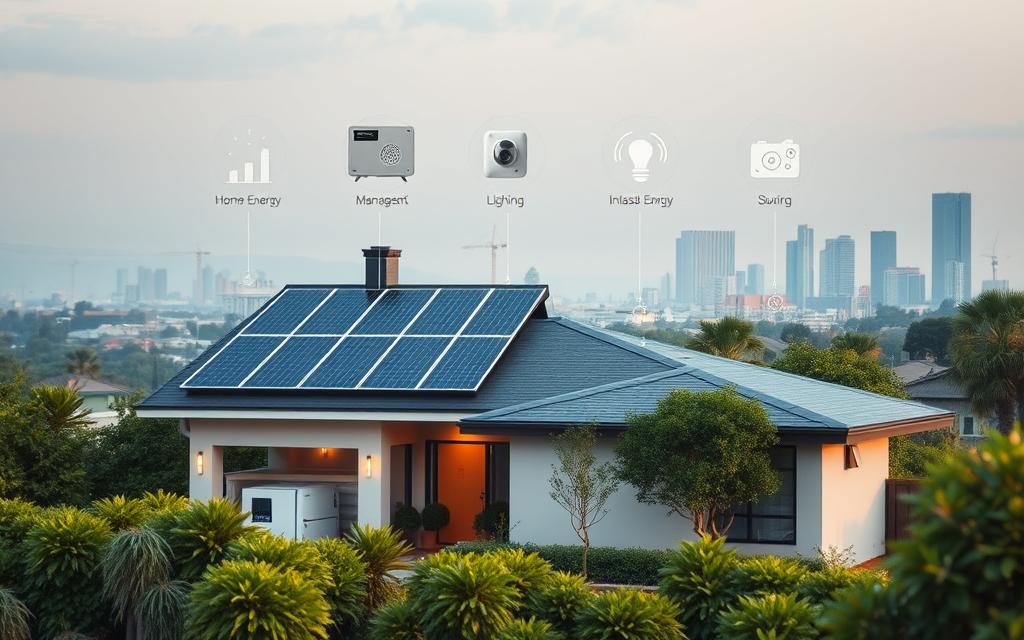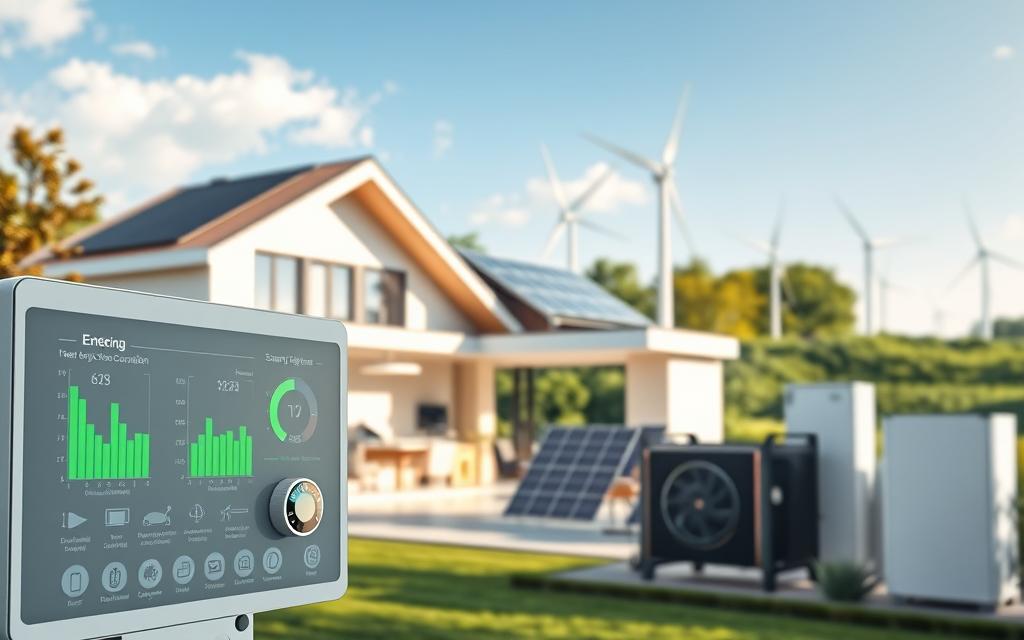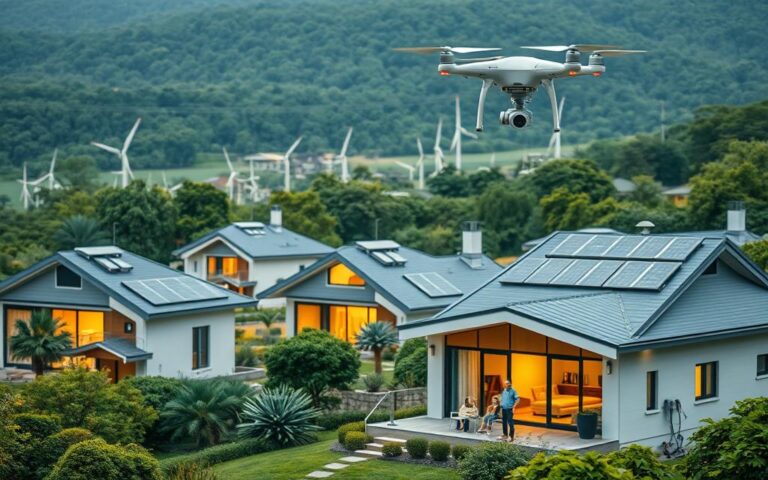Did you know homes with smart energy tech can cut energy use by up to 30%? This shows how smart home energy can make our homes greener. More people want to add smart systems to save energy and make their homes more comfortable.
This article will show you how to make your home a smart energy hub. We’ll cover what smart home energy is, its key parts, and how to set it up. Learning these basics will help you make your home more energy-efficient and eco-friendly.
Understanding Smart Home Energy Concepts
Smart home energy uses advanced tech to manage and watch energy use at home. Homeowners can cut down on energy use by automating things and getting real-time data.
What is Smart Home Energy?
Smart home energy means using a system that connects devices for better energy use. It lets homeowners use devices that save energy. Key items include smart thermostats, energy-saving lights, and smart appliances that change based on what you like.
Benefits of Improved Energy Management
Using smart home energy systems has many benefits. It can lower your utility bills because devices adjust energy use on their own. It also makes your home more comfortable, letting you adjust settings to your liking.
These systems are good for the planet too, using less energy and cutting down on waste. Plus, they make your life easier by automating tasks. This makes living in an energy-efficient home both easy and smart.
Key Components of a Smart Energy Hub
To create a smart energy hub, you need certain parts that help save energy and support green living. Key items like smart thermostats, smart lighting, and energy monitoring systems make managing energy easy. This leads to a more efficient home automation experience.
Smart Thermostats
Smart thermostats change how we control temperature, adjusting heating and cooling based on our needs and when we’re home. Brands like Nest and Ecobee let you set schedules, control temperatures from afar, and learn your habits. These devices help save energy, cutting down on waste and costs.
Smart Lighting
Smart home lighting makes life easier and more energy-efficient. You can control lights with apps or voice commands. Brands like Philips Hue or LIFX offer customizable lights and automation, saving energy when rooms are empty. This shows how important smart lighting is for a greener home.
Energy Monitoring Systems
Energy monitoring systems let you see how much energy you use in real time. They show you where you can cut back. Devices like Sense or Neurio help find energy-wasting appliances and improve your energy use. These systems help you live more sustainably and efficiently.
Selecting the Right Technology for Your Home
Choosing the right technology for your home is key to a sustainable lifestyle. Making smart choices about energy solutions means your devices will fit your needs and lifestyle. Look at factors like compatibility, ease of use, brand reliability, and special features when deciding.
Comparing Smart Home Devices
When looking at smart home devices, make a list of what’s important to you. Brands like Nest, Ecobee, and Philips Hue have many options. Think about what features you need, like remote control or voice assistant integration.
Read reviews and compare features to find the best fit for your energy goals. This way, you’ll choose devices that work well together and meet your needs.
Integrating with Other Smart Systems
Smart home devices are powerful when they work together. They should fit with your current systems for better use and efficiency. Look for devices that use protocols like Z-Wave and Zigbee for easy integration.
By linking different technologies, you create a system that’s easy to use and efficient. This makes managing your home’s energy simpler and more effective.
Setting Up Your Smart Energy Hub
Setting up a smart energy hub needs careful planning and execution. By following a detailed installation guide, homeowners can enjoy energy-saving smart home tech. This step-by-step method ensures devices work together well, making energy management smart and efficient.
Step-by-Step Installation Guide
Start by collecting all devices and reading their manuals carefully. Each device, like smart thermostats and energy monitors, has its own installation needs. Here’s a simple guide:
- Choose a spot for your central hub and make sure it’s near Wi-Fi.
- Install your smart thermostat by following the wiring diagrams. Make sure it connects to your HVAC system.
- Replace old bulbs with smart ones and link them through the app.
- Put energy monitors on your electrical panel, following the safety instructions carefully.
Connecting Your Devices
After installing each device, connect them in your smart system. Follow these steps:
- Open the apps for each device and create an account if needed.
- Make sure all devices are on and connected to your Wi-Fi.
- Go to the app settings to add and set up each device, so they can talk to each other.
- Test the connections by using the app to send commands and see if they work.
Your smart energy hub is ready to go. It lets users control and monitor energy use easily. This shows how important smart home tech is for saving energy.
| Device Type | Installation Complexity | Smart Features |
|---|---|---|
| Smart Thermostat | Medium | Remote control, scheduling, energy reports |
| Smart Lighting | Easy | Voice control, dimming, smart scheduling |
| Energy Monitoring System | High | Real-time monitoring, energy usage insights |
Optimizing Energy Consumption
Looking for ways to use less energy at home can save money and help the planet. Using smart devices and understanding energy use are key to saving energy. These steps are important for a smart home to work well.
Scheduling Devices for Efficiency
One easy way to save energy is to set devices to turn on when it’s cheaper. This cuts down on costs and helps the power grid. Smart lights and appliances can be set to run when it’s less busy.
Homeowners can save a lot and use less energy. Many smart systems have apps that make it easy to follow these tips.
Utilizing Energy Reports and Insights
Smart systems give detailed reports on energy use. These reports show which devices use the most energy. They also offer tips to use less.
By looking at this data, people can make better choices. This helps them use energy more wisely. It’s a step towards living more sustainably.
Enhancing Security and Safety with Smart Energy
Using eco-friendly smart home solutions boosts energy efficiency and home security. Smart energy devices help monitor your home and warn you of dangers. They make your daily life safer and more efficient.
Smart Sensors for Energy Efficiency
Smart sensors are key in today’s homes. They track motion and appliance use, helping save energy. These sensors work with smart energy systems to show how much energy you use live.
By linking motion sensors with energy systems, homes can use less energy. Lights and heat adjust automatically based on who’s home.
Fire and Carbon Monoxide Safety Systems
Adding fire and carbon monoxide systems to your smart home is smart. They alert you to dangers quickly, keeping you safe. Linked to energy systems, they warn of electrical issues before they become big problems.
| Device Type | Functionality | Benefits |
|---|---|---|
| Smart Sensors | Monitor motion and usage | Energy savings and efficiency |
| Fire Safety System | Detects smoke and fire | Emergency alerts for quick response |
| Carbon Monoxide Detector | Monitors CO levels | Life-saving alerts for dangerous gas |
Smart technologies make your home safer and more eco-friendly. Smart sensors and safety systems show your dedication to energy and safety. They highlight the importance of smart home energy monitoring in today’s world.

Exploring Renewable Energy Options
Adding renewable energy to your home boosts green energy home automation and supports sustainable home technology. It helps cut down on traditional energy use. Solar panels and battery storage are key to a well-working energy system.
Solar Panels and Smart Homes
Solar panels are essential for a smart energy system. They use the sun’s power, making them a green choice. Installing them can lower your energy bills and reduce carbon emissions.
With smart integration, you can track your energy use. This leads to better energy management.
Integrating Battery Storage Solutions
Battery storage solutions work with solar panels to save extra energy. This way, you can use renewable energy even when it’s not sunny. Solar panels and batteries together ensure a steady energy supply.
This setup makes your home more energy-independent. It also helps the environment by using energy wisely.
Future Trends in Smart Home Energy
Smart home energy systems are getting better, leading to more energy-saving tech. These changes will make managing home energy more efficient and green. They promise exciting updates that will help us use energy better.
Emerging Technologies to Watch
New tech is coming that will change how we handle energy at home. Better AI will help us use less energy by giving us tips based on our habits. IoT devices will talk to each other, making homes more efficient.
Blockchain tech will also let us trade energy with our neighbors. This means we can sell extra energy and buy what we need.
Predictions for Smart Energy Solutions
The future of smart home energy looks very promising. Devices will work better together, making it easier to manage energy. This will help families save energy and money.
As these changes happen, our daily lives will change too. We’ll use energy in new ways that are better for the planet.
Conclusion: Making Your Home Smarter and Greener
Turning a regular home into a smart energy center brings big benefits. It’s good for homeowners and the planet. With eco-friendly smart home tech, you get more convenience, save energy, and lower bills.
Smart tech helps us live more sustainably. It’s key for our planet. By using devices wisely and choosing green energy, we save energy.
Sharing what we know about smart homes is important. It encourages others to be eco-friendly too. This builds a community that cares about the planet.
Working together, we can make our homes more energy-efficient. Sharing tips and resources helps everyone. Every small step we take helps make a big difference in how we use energy.



